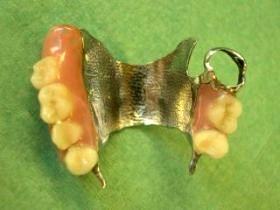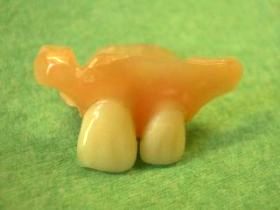Prostheses
Missing teeth can be replaced with removable prostheses (denture) or with fixed restorations (bridge etc.).
Removable prosthodontic restoration (denture)
When there is not a sufficient number of teeth to hold the prosthesis only a removable prosthesis (denture) can be prepared. A full restoration is needed if the patient does not have any more teeth and a partial denture if the patient has some teeth. The partial denture has to be removed only when cleaned (in the morning and in the evening) and it can be worn during the night as well. (The removed denture does not have to be kept in water.)

Upper partial denture
The plate of the partial denture is usually made of metal.
The denture may be fixed to the teeth in various ways:
- with clasps (it has the advantage that in this case teeth usually do not have to be chiselled; its disadvantage is that the fasteners can be seen and the denture is less stable),
- concealed, precision-fastening devices (these are fasteners similar to a press-stud and have the advantage that they cannot be seen and the denture is more stable; the disadvantage is that for a part of the teeth crowns have to be prepared).
Temporary crown, −bridge, −denture
In the course of dental treatments often temporary prosthesis (crown, bridge, removable denture) are needed for aesthetic
reasons or in order to restore the bite. Temporary prostheses can serve the above aims in almost every case, with some
limitations, for the total length of the treatment.
In the majority of the cases the patient can decide whether he/she needs a temporary solution (e.g. in case of a simple
prosthesis a temporary bridge) but in some cases it is needed in any case (e.g. root canal treatments, periodontitis,
implants).

Temporary partial denture 1.

Temporary partial denture 2.